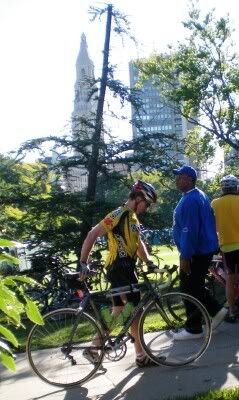 People began gathering in Bushnell Park before seven on Saturday morning. Tents had to be set up throughout the park for three unrelated events that were scheduled at the same time. On one side was a gospel event with two stages. On the other was the annual Grandparents’ Day celebration and the start/finish point for the Discover Hartford Bicycling and Walking Tour, complete with two stages between these events.
People began gathering in Bushnell Park before seven on Saturday morning. Tents had to be set up throughout the park for three unrelated events that were scheduled at the same time. On one side was a gospel event with two stages. On the other was the annual Grandparents’ Day celebration and the start/finish point for the Discover Hartford Bicycling and Walking Tour, complete with two stages between these events.
The Discover Hartford event is not a marathon. It’s not a race. Not a competition. Before the first ever Discover Hartford tour I had the opportunity to interview a key organizer, who excitedly explained that it would be an “anti-sprawl, pro-fun, pro-sustainable city, anti-pollution, anti-couch potato, pro-bicycle pro-pedestrian event” meant to show off all the great places within the city of Hartford. It was the chance for those who never come to Hartford, or only see a limited part of it, to experience it more fully. Those who opt to walk routes receive a guided tour. Those who ride experience more of the city, but without the guide. In any case, people would see that Hartford is more than the civic center, fast food chain on the corner of Asylum and Main, and the Bushnell.
Yesterday, I saw a beautiful old building that used to be a synagogue but is now being used as a church. This was a part of Hartford’s history that I understood well. There was a strong Jewish population on the North side, which packed up and moved out to the suburbs, leaving behind ornate, lovely buildings and cemeteries.
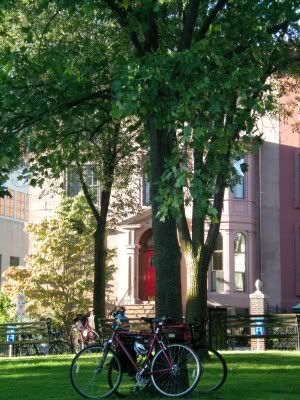 Aside from a few events at the Charter Oak Cultural Center (south of Downtown), none of the synagogues in Hartford function as they were intended.
Aside from a few events at the Charter Oak Cultural Center (south of Downtown), none of the synagogues in Hartford function as they were intended.
While riding between Keney Park and Riverside Park, we passed through what appeared to be a suburban neighborhood. The houses were all of the same style. The lawns were green and decent-sized. Every house on the street had the exact same style mailbox. If Donna Reed greeted us all with cookies I would have been less surprised. I have driven and ridden through the North Meadows, North East, and Clay Arsenal neighborhoods before, but somehow missed this street.
Keney Park, or at least the sections we rode through, looks healed. I could count the pieces of litter on one hand. Usually, I don’t bother counting. I saw no bulky items; usually it’s a dumping ground for mattresses and tires. The Week of the Parks definitely helped out the largest park in Hartford. This is where we had a rest stop on the 25-mile loop. The rest stop on the 10-mile loop was at the other spot where one can golf– Goodwin Park. 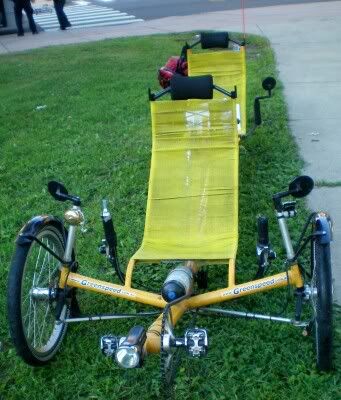 The tour took us as far north, south, east, and west as one could be in Hartford.
The tour took us as far north, south, east, and west as one could be in Hartford.
Along the eastern border, we rode along the Connecticut River, entering the path at Riverside Park and exiting before reaching Charter Oak Landing. It is possible to bike through, but the path becomes dirt and would be too difficult for a number of riders. I have no idea how the recumbent or tandem bikes would have fared, but I’m sure that the kid riding the unicycle would have managed just fine.
The tour began on Elm Street and headed further into Downtown at first. Cyclists bottle-necked in a few spots like Temple Street, which is a narrow street made narrower by trucks parked in non-designated parking spaces. Participants were able to see the relatively new construction there, along with several new restaurants. Heading down Columbus Boulevard gave riders a look at the newish Connecticut Science Center, Convention Center, hotel, and Front Street development. Later, we would ride through Front Street, which is basically complete, aside from actually having occupied storefronts.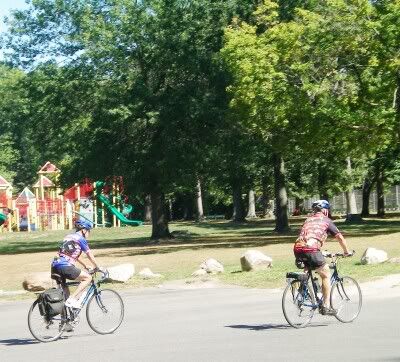 A few months ago I was informed by the Front Street/Adriaen’s Landing folks that there would be a major announcement in August about progress; it’s well into September and I have heard nothing.
A few months ago I was informed by the Front Street/Adriaen’s Landing folks that there would be a major announcement in August about progress; it’s well into September and I have heard nothing.
We headed from Downtown to Trinity College and rode across its lovely campus, which has some of the best bicycle parking in Hartford. Between Trinity College and Goodwin Park, some cyclists took an optional one-mile loop through Cedar Hill Cemetery, where Katharine Hepburn and other famous (and not famous) folks permanently reside.
The tour then took the last street in Hartford (before the Wethersfield line) before turning north up Franklin Avenue. I only saw two cyclists stop into one of the many bakeries on the street. If I had brought money with me, I might have spent the next half hour in Modern Pastry.
Instead of riding through Colt Park, we rode just outside of it, past the Virgin Mary shrine(s). We headed through the housing that had been set up for Colt factory workers.
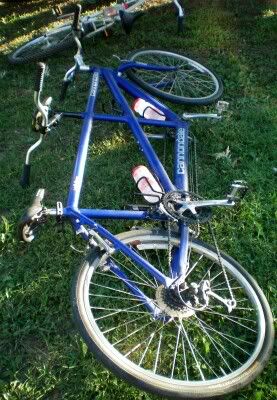 As we made it up Capitol Avenue, the 10-mile riders headed back to Bushnell Park, while those attempting longer distances moved along, then up Park Terrace. And by up, I mean up. I ride often on Park Terrace. It’s near where I live. It’s fun. But before yesterday, I only rode it toward Capitol Avenue, not from it. What made it fun in the past was that I could go fast with no effort. Well, riding it uphill was no fun, but the reward was a trip through Pope Park. Later, I overheard someone asking about this “Pope character.” It sounded sort of blasphemous for a cyclist to not know about Pope. After the park loop, we rode down Laurel Street and then headed off in the direction of Asylum Hill, then the West End. If nothing else, this ride showed that the entire vibe can change within one or two blocks. Riding past the seminary and law school, it was almost silent. Nothing happening. Nobody outside. Everything changed when we landed on Woodland Street. There was suddenly traffic. We passed families while entering Keney Park. On side streets along the park, little kids stood in front of their houses and waved to us. Some older folk cheered cyclists along.
As we made it up Capitol Avenue, the 10-mile riders headed back to Bushnell Park, while those attempting longer distances moved along, then up Park Terrace. And by up, I mean up. I ride often on Park Terrace. It’s near where I live. It’s fun. But before yesterday, I only rode it toward Capitol Avenue, not from it. What made it fun in the past was that I could go fast with no effort. Well, riding it uphill was no fun, but the reward was a trip through Pope Park. Later, I overheard someone asking about this “Pope character.” It sounded sort of blasphemous for a cyclist to not know about Pope. After the park loop, we rode down Laurel Street and then headed off in the direction of Asylum Hill, then the West End. If nothing else, this ride showed that the entire vibe can change within one or two blocks. Riding past the seminary and law school, it was almost silent. Nothing happening. Nobody outside. Everything changed when we landed on Woodland Street. There was suddenly traffic. We passed families while entering Keney Park. On side streets along the park, little kids stood in front of their houses and waved to us. Some older folk cheered cyclists along.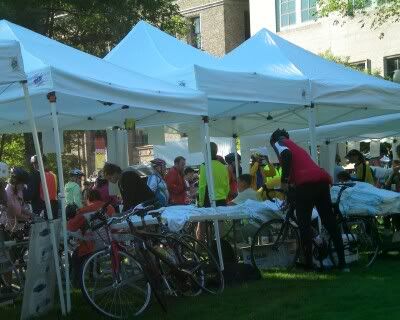
This year, cyclists had the option to take a 40-mile loop, which involved riding to Hartford-owned Batterson Park, located in Farmington. Whichever route people walked or biked, it should have been immediately clear that the Hartford they saw and experienced was not quite the same as the one frequently portrayed on the news. The closest thing to a gunshot that we heard was someone’s tire blowing out. Bulletproof vests were not necessary, though comfortable saddles were, as potholes were the largest source of discomfort for some.
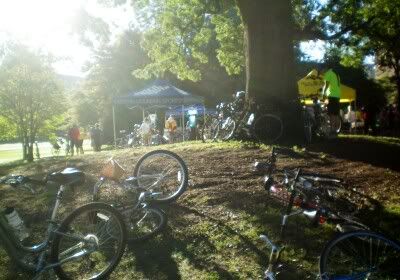
As mentioned in previous posts, the registration fee for this was steep. It costs a lot to put on this kind of event, but such fees do discourage a number of residents from participating. I spoke to at least one rider who had not bothered to pay. She simply brought herself, bicycle, and helmet, and rode along. Conscious about her lack of payment, she did not partake of the refreshments provided. This seems like one responsible way to manage the sometimes prohibitive fees. Encourage everyone to ride and assume that someday they will have more disposable income. This is how academic conferences handle the issue. There are sliding scale rates, making participation more possible for students who will likely be able to cough up more money at a later date. Lacking a sliding scale rate for such events is just

More photos from the event below:
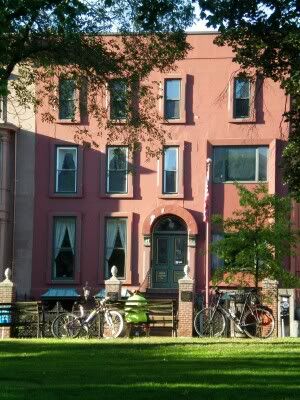
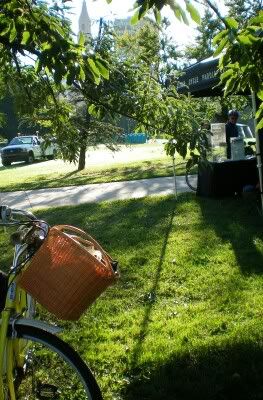
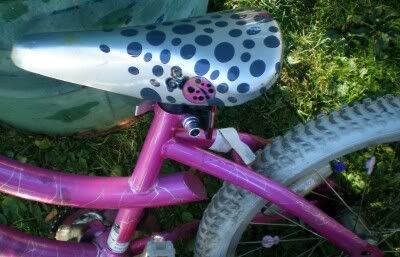
Cyclists of all ages participated.

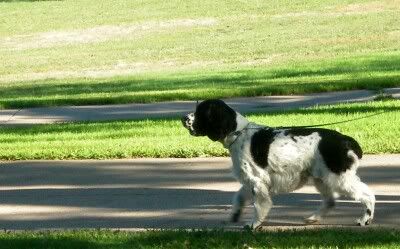
I think this dog was just passing through, but too cute to not take a picture of.
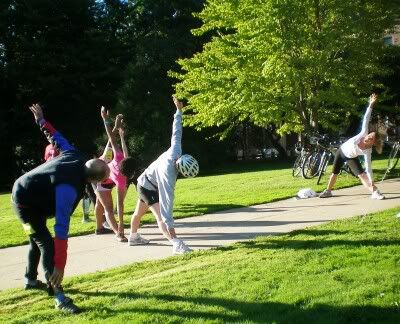
Free yoga was available for participants before the walk/ride.
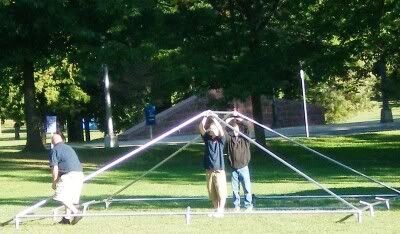

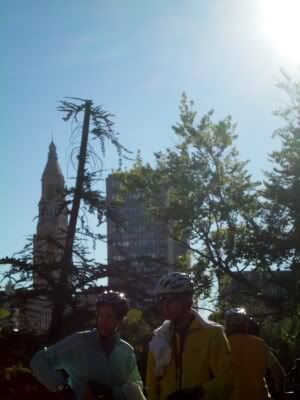
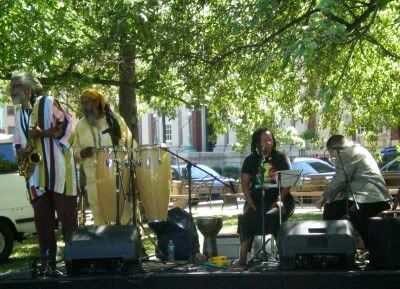
Musical entertainment was provided after the tour.
Real Hartford » Magical History Tour
[…] after yesterday’s bicycle ride you’re still able move, there is another event involving two wheels and the city. On […]